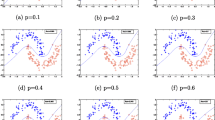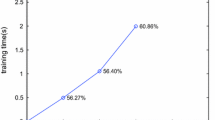Abstract
Twin support vector machine (TWSVM) learns two nonparallel hyperplanes for binary class classification problems. It assumes that the training data can be collected accurately without any uncertain information. However, in practical applications, the data may contain uncertain information. To deal with the uncertain information, this paper puts forward a novel uncertain-data-based least squares twin support vector machine method (ULSTSVM) which is capable of handling the data uncertainty efficiently. Firstly, since the data may contain uncertain information, a noise vector is introduced to model the uncertain information of each example. Secondly, the noise vectors are incorporated into least squares TWSVM. Finally, to solve the derived learning problem, we employ a two-step heuristic framework which trains the least squares TWSVM classifier and updates the noise vectors alternately. The experimental results have shown that ULSTSVM surpasses the existing robust TWSVM methods in training time and meanwhile achieves a better classification accuracy. In sum, ULSTSVM adopts a noise vector to model the uncertain information and transforms the quadratic programming problems of TWSVM into linear equations, which makes us have a better classification accuracy and higher training efficiency.







Similar content being viewed by others
References
Cortes C, Vapnik V (1995) Support-vector networks. Mach Learn 20(3):273–297
Li S, Kwok JT, Zhu H, Wang Y (2003) Texture classification using the support vector machines. Pattern Recogn 36(12):2883–2893
Khan NM, Ksantini R, Ahmad IS, Boufama B (2012) A novel svm+ nda model for classification with an application to face recognition. Pattern Recogn 45(1):66–79
Zhang G, Gao F, Liu C, Liu W, Yuan H (2010) A pedestrian detection method based on svm classifier and optimized histograms of oriented gradients feature. In: 2010 Sixth International conference on natural computation, vol 6. IEEE, pp 3257–3260
Adankon MM, Cheriet M (2009) Model selection for the ls-svm. application to handwriting recognition. Pattern Recogn 42(12):3264–3270
Mangasarian OL, Wild EW (2005) Multisurface proximal support vector machine classification via generalized eigenvalues. IEEE Trans Pattern Anal Mach Intell 28(1):69–74
Jayadeva R, Chandra S (2007) Khemchandani Twin support vector machines for pattern classification. IEEE Trans Pattern Anal Mach Intell 29:905–910
Chen X, Yang J, Ye Q, Liang J (2011) Recursive projection twin support vector machine via within-class variance minimization. Pattern Recogn 44(10–11):2643–2655
Shao YH, Zhang C, Wang XB, Deng NY (2011) Improvements on twin support vector machines. IEEE Trans Neural Netw 22(6):962–968
Peng X (2010) A ν-twin support vector machine (ν-tsvm) classifier and its geometric algorithms. Inform Sci 180(20):3863–3875
Kumar MA, Gopal M (2009) Least squares twin support vector machines for pattern classification. Pergamon Press Inc.
Tanveer M, Sharma A, Suganthan PN (2021) Least squares knn-based weighted multiclass twin svm. Neurocomputing 459:454–464
Tanveer M, Sharma S, Muhammad K (2021) Large-scale least squares twin svms. ACM Trans Internet Technol (TOIT) 21(2):1–19
Gao Z, Fang S-C, Gao X, Luo J, Medhin N (2021) A novel kernel-free least squares twin support vector machine for fast and accurate multi-class classification. Knowl-Based Syst 226: 107123
Richhariya B, Tanveer M, SIIP (2021) Alzheimer’s Disease Neuroimaging Initiative Discipline of Mathematics, Indian Institute of Technology Indore. An efficient angle-based universum least squares twin support vector machine for classification. ACM Trans Int Technol (TOIT) 21(3):1–24
Chen S-G, Wu X-J, Xu J (2020) Locality preserving projection least squares twin support vector machine for pattern classification. Pattern Anal Applic 23(1):1–13
Zhao J, Xu Y, Fujita H (2019) An improved non-parallel universum support vector machine and its safe sample screening rule. Knowl-Based Syst 170:79–88
Huang H, Wei X, Zhou Y (2018) Twin support vector machines: a survey. Neurocomputing 300:34–43
Huang H, Wei X, Zhou Y (2022) An overview on twin support vector regression. Neurocomputing
Ren Q, Yang L (2022) A robust projection twin support vector machine with a generalized correntropy-based loss. Appl Intell 52(2):2154–2170
Li K, Lv Z (2021) Smooth twin bounded support vector machine with pinball loss. Appl Intell 51(8):5489–5505
Borah P, Gupta D (2021) Robust twin bounded support vector machines for outliers and imbalanced data. Appl Intell 51(8):5314–5343
Qi Z, Tian Y, Shi Y (2013) Robust twin support vector machine for pattern classification. Pattern Recogn 46(1):305– 316
Richhariya B, Tanveer M (2018) A robust fuzzy least squares twin support vector machine for class imbalance learning. Appl Soft Comput 71:418–432
Ganaie M, Tanveer M, Suganthan PN (2020) Regularized robust fuzzy least squares twin support vector machine for class imbalance learning. In: 2020 International joint conference on neural networks (IJCNN). IEEE, pp 1–8
Sartakhti JS, Afrabandpey H, Ghadiri N (2019) Fuzzy least squares twin support vector machines. Eng Appl Artif Intel 85:402–409
Ganaie M, Tanveer M, Initiative ADN et al (2021) Fuzzy least squares projection twin support vector machines for class imbalance learning. Appl Soft Comput 113:107933
Chen S, Cao J, Chen F, Liu B (2020) Entropy-based fuzzy least squares twin support vector machine for pattern classification. Neural Process Lett 51(1):41–66
Richhariya B, Tanveer M (2021) A fuzzy universum least squares twin support vector machine (fulstsvm). Neural Comput Applic, 1–12
Yuan C, Yang L (2021) Capped l2, p-norm metric based robust least squares twin support vector machine for pattern classification. Neural Networks
Mairal J, Bach F, Ponce J, Sapiro G (2009) Online dictionary learning for sparse coding. In: Proceedings of the 26th annual international conference on machine learning, pp 689–696
Wang L, Huang J, Yin M, Cai R, Hao Z (2020) Block diagonal representation learning for robust subspace clustering. Inform Sci 526:54–67
Wang F, Zhao B, Zhang C (2010) Linear time maximum margin clustering. IEEE Trans Neural Netw 21(2):319–332
Liu B, Xiao Y, Cao L, Yu PS (2011) One-class-based uncertain data stream learning. In: Proceedings of the 2011 SIAM international conference on data mining. SIAM, pp 992–1003
Bi J, Zhang T (2005) Support vector classification with input data uncertainty. Adv Neural Inform Process Syst 17(1):161–168
Golub GH, Van Loan CF (2013) Matrix computations, vol 3. JHU Press
Zhang S, Lai H, Chen W, Zhang L, Lin X, Xiao R (2022) Vblsh: volume-balancing locality-sensitive hashing algorithm for k-nearest neighbors search. Inform Sci 587:774–793
Pan J, Manocha D (2012) Bi-level locality sensitive hashing for k-nearest neighbor computation. In: 2012 IEEE 28th International conference on data engineering. IEEE, pp 378–389
Tsang S, Kao B, Yip KY, Ho WS, Lee SD (2009) Decision trees for uncertain data. IEEE Trans Knowl Data Eng 23(1):64–78
Kriegel HP, Pfeifle M (2005) Hierarchical density-based clustering of uncertain data. In: IEEE international conference on data mining
Gao C, Wang J (2010) Direct mining of discriminative patterns for classifying uncertain data. In: Proceedings of the 16th ACM SIGKDD international conference on knowledge discovery and data mining, Washington, DC
Yin J, Yang Q, Pan JJ (2008) Sensor-based abnormal human-activity detection. IEEE Trans Knowl Data Eng 20(8):1082–1090
Musicant D (1998) Ndc: normally distributed clustered datasets. Computer Sciences Department. University of Wisconsin, Madison
Acknowledgments
The authors would like to thank the reviewers for their very useful comments and suggestions. This work was supported in part by the Natural Science Foundation of China under Grant 61876044 and Grant 62076074, in part by Guangdong Natural Science Foundation under Grant 2020A1515010670 and 2020A1515011501 in part by the Science and Technology Planning Project of Guangzhou under Grant 202002030141.
Author information
Authors and Affiliations
Corresponding author
Additional information
Publisher’s note
Springer Nature remains neutral with regard to jurisdictional claims in published maps and institutional affiliations.
Rights and permissions
About this article
Cite this article
Xiao, Y., Liu, J., Wen, K. et al. A least squares twin support vector machine method with uncertain data. Appl Intell 53, 10668–10684 (2023). https://doi.org/10.1007/s10489-022-03897-3
Accepted:
Published:
Issue Date:
DOI: https://doi.org/10.1007/s10489-022-03897-3




